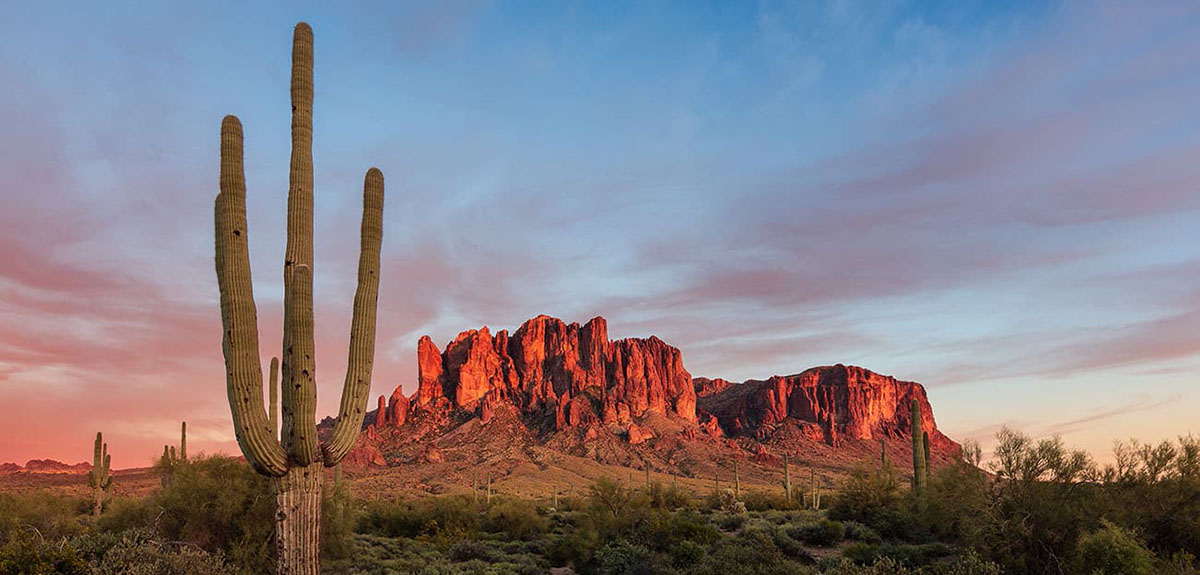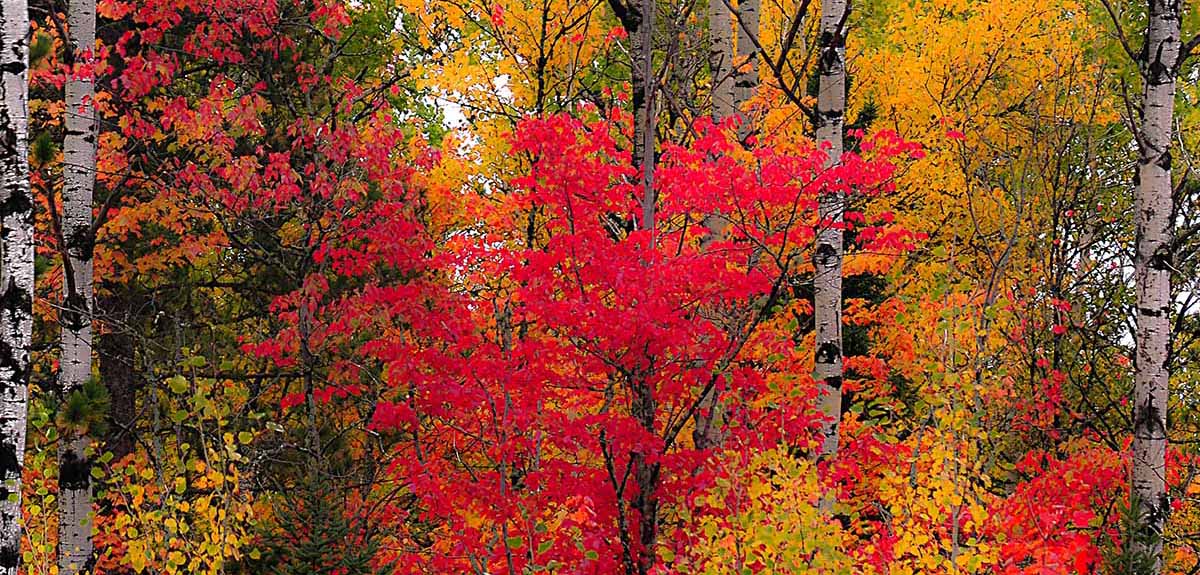Roadtripping Virginia’s Blue Ridge Parkway
Image Caption:
The Blue Ridge Parkway, nicknamed “America’s Favorite Drive,” is a 469-mile road that snakes along the crest of the Appalachian Mountains between North Carolina’s Great Smoky Mountains National Park at the south end and Virginia’s Shenandoah National Park at the north end. Noted as the longest scenic road in America that was planned as a single unit, construction began in 1935, just two years after President Roosevelt drove the Skyline Drive that traverses Shenandoah National Park, inspiring him to connect these two great national parks with a scenic road.
The parkway’s sweeping turns and breathtaking views lure many motorhome travelers along its length. The northern half of the Blue Ridge Parkway, in Virginia, is RV-friendly, save for the Bluff Mountain tunnel at milepost 53.1, which may be a tight squeeze with a clearance of 13 feet 7 inches. On a recent road trip, my husband, Mark, and I used the parkway as a guide to cross Virginia from south to north. We hopped on and off frequently to enjoy not only the serene beauty of the drive itself, but a wide variety of intriguing attractions nearby.
The Blue Ridge Parkway’s points of interest appear on maps by milepost numbers that decrease from south to north. The border between North Carolina and Virginia is at milepost 217.
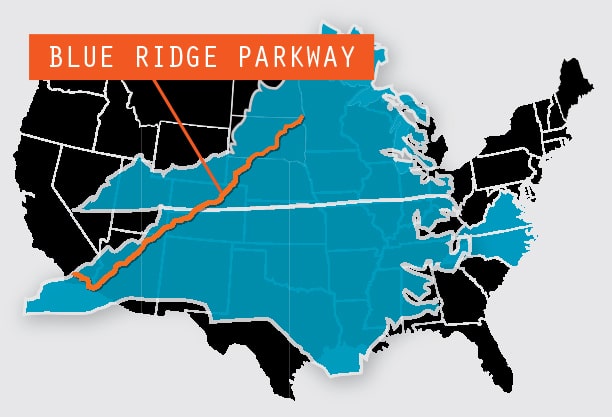
Getting There: The parkway connects Shenandoah National Park, near Waynesboro, Virginia (milepost 0), with Great Smoky Mountains National Park, near Cherokee, North Carolina (milepost 469). There are entrances and exits at all major highways. In Virginia, interstates 64, 81 and 77 all have directions for accessing the parkway; the same is true for interstates 40 and 26 in North Carolina.
Blue Ridge Music Center
Our first stop after entering Virginia from the south was at the Blue Ridge Music Center, at milepost 213. We were absolutely charmed by this unique National Park Service offering which is both a museum and a music performance venue that celebrates the history of bluegrass music. When we stepped inside, we were surrounded by a fantastic collection of displays and plaques that explain the multicultural source of this colorful music.
We were fascinated to learn that the banjo has its origins in West Africa. Slaves shipped to America in the 1600s brought with them the knowledge and skills for making and playing the banjo. At the same time, immigrants from the British Isles brought their fiddles and love of ballads and dance music. These two musical traditions began to blend in the remote rural areas of the Appalachian Mountains, and the roots of country music took hold. The advent of the phonograph and radio, and the ability to transmit music on the radio in the 1920s and 1930s, brought this unique sound to far-flung listeners, and a lively style of iconic American music was born.
Every afternoon during the summer, the Bluegrass Music Center presents a free four-hourlong concert in the breezeway attached to the museum. We were delighted by a pair of musicians, Scott Freeman and Willard Gayheart, who played one spirited duet after another on banjo and guitar. The audience was casually seated on folding chairs around them, and listeners came and went between songs on their way in and out of the museum.
Galax, Virginia
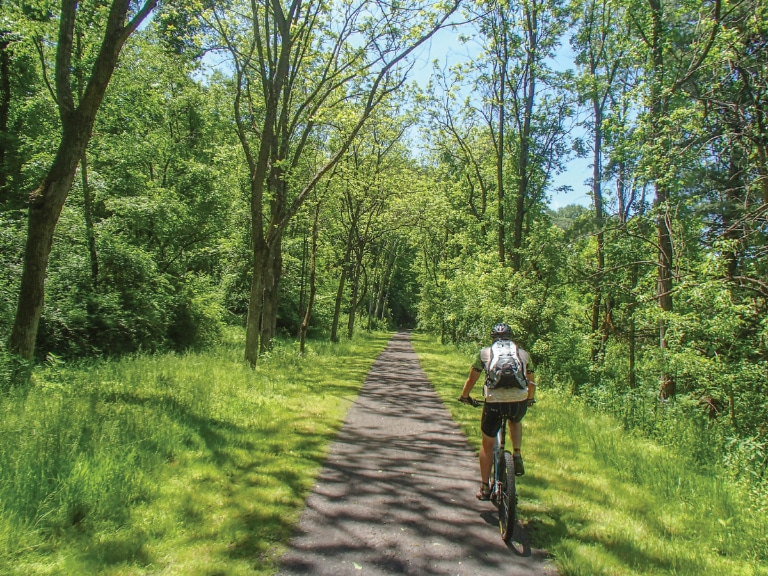
The scenic 57-mile-long New River Trail, a rails-to-trails bike path and state park, starts in Galax, Virginia.
Just a few miles from the Bluegrass Music Center, we discovered the small town of Galax, Virginia, which is the starting point for the 57-mile-long New River Trail, a flat and wide rails-to-trails bike path and state park that extends far into the countryside. Winding along the edge of a river, we met families on bikes and walkers with dogs, all enjoying this lovely trail. Several walk-in and bike-in campgrounds are scattered along this bike path, and we were intrigued to see a few long-distance touring cyclists traveling on the New River Trail on bicycles loaded with bedrolls and sleeping bags as they traveled from campground to campground. After our ride, we found an ideal spot for a post-ride microbrew at Creek Bottom Brewing in Galax, which serves craft beers from all over the country. Their wood-fired pizza is truly out of this world, and enticed us back a second day.
Mabry Mill
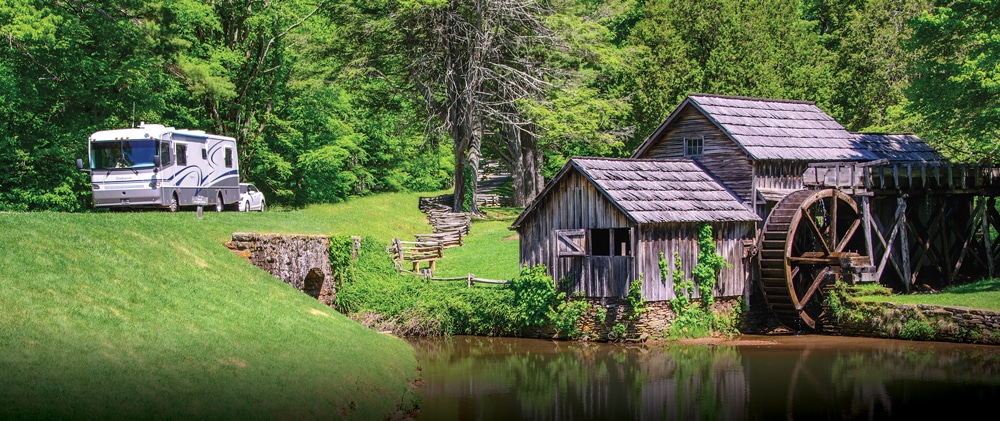
A motorhome drives past Mabry Mill at milepost 176.
Heading north again on the Blue Ridge Parkway to milepost 176, we came to beautiful Mabry Mill, a classic gristmill dating back to 1905. This historic building stands next to a pretty pond, and if you are there when the enormous rhododendron bushes are in bloom in the spring, you can get a fabulous photograph of the mill, framed by lavender flowers. We happily joined a small group of camera-wielding tourists to get a photo of our own, and later discovered that this is the most photographed spot on the Blue Ridge Parkway.
Inside the mill we saw a terrific demonstration of how paddle wheels were used to generate power a century ago. They were used not only to grind wheat and corn, but to operate enormous saws, drills and tongue-and-groove joiners as well. A long lever arm “brake” inside the building starts or stops the water flow over the paddle wheel outside. Once the wheel was rotating, huge interlocking gears inside the mill would begin to turn, generating the power to mash seeds on a grindstone or to move a saw blade back and forth. The ingenuity of this pre-electricity power plant tucked into the back hills of Virginia was astounding. Like gristmills all across the country, the man who built it essentially provided power to his neighbors, who brought grain and lumber to his mill for grinding and cutting.
Chateau Morrisette
Our minds still reeling as we left the immensely innovative yet achingly crude mechanical marvels of yesteryear behind, we changed gears completely as we proceeded a few miles north on the Blue Ridge Parkway to the elegant Chateau Morrisette at milepost 172. Towering bushes of rhododendrons were bursting with color throughout the gracefully landscaped winery grounds, and it was easy to see why this is a favorite spot for weddings. They offered wine tastings in a grand tasting room, but their wines could be enjoyed even more when paired with a tasty meal in the restaurant overlooking the picturesque vineyard.
Floyd, Virginia
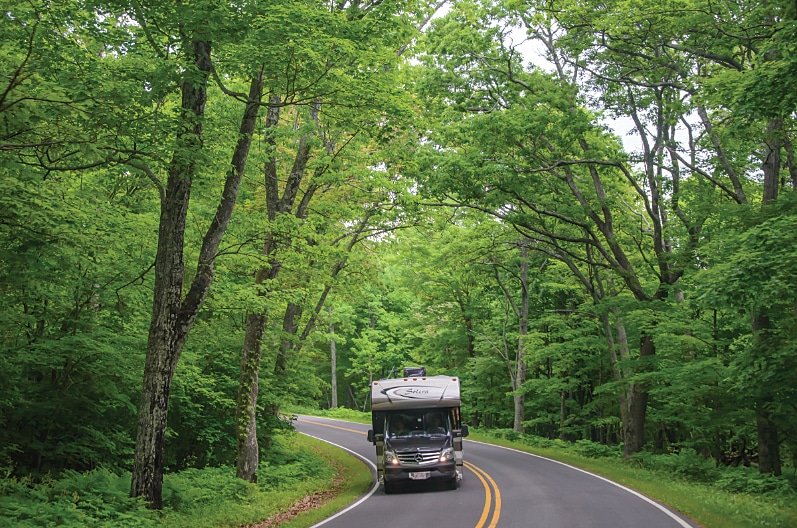
Driving under a green canopy on the Blue Ridge Parkway.
Our eyes and taste buds had been fully stimulated by the sights and flavors we’d been savoring along the parkway so far, but we had a hankering to engage our ears once again and listen to more of the musical sounds of Appalachia. In Floyd, Virginia, just off of Tuggle Gap at milepost 165, we found an incredible venue for witnessing and participating in free bluegrass music jam sessions.
The Floyd Country Store stands in the middle of the tiny town of Floyd, but somehow we missed it completely and walked right past, noticing only that there were an awful lot of people hanging around on the sidewalk eating ice cream cones under a sign that said, “Loitering allowed.” When we reached the end of town without having found the store anywhere, we turned back only to discover that the crowd of ice cream cone eaters was standing right in front of it! As we soon learned, not only does this unique country store offer a fabulous place for people from far and wide to make music together out back, but it is a true old-time country store out front.
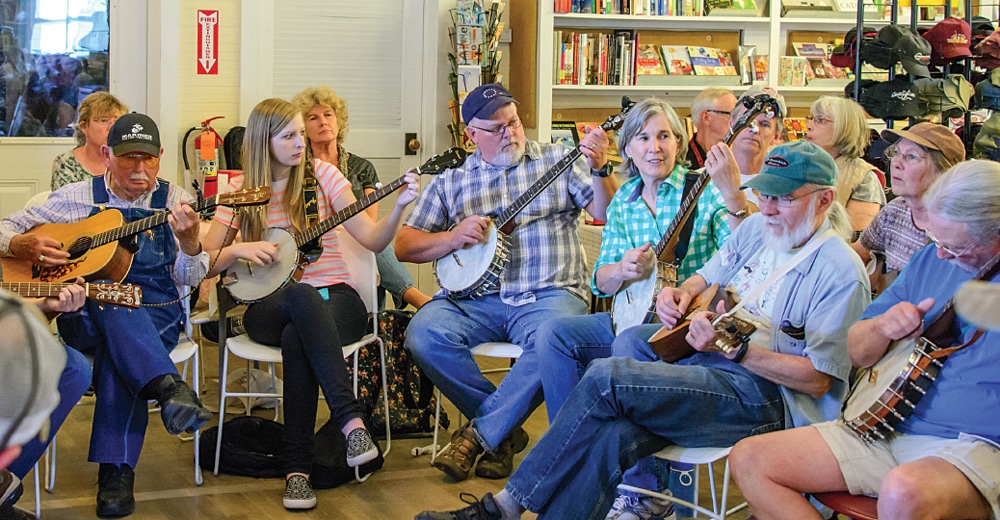
Free bluegrass jam sessions delight at Floyd Country Store, where a sign declares “Loitering allowed.”
We wandered in, and just then the most magical sound filled the air as about 30 musicians sitting in a large circle at the back of the store spontaneously jumped into a rip-roaring tune. The jam session was completely impromptu, and there wasn’t a piece of sheet music to be seen anywhere. Banjos, guitars, fiddles, basses and dobros were everywhere, and the musicians were happily a-pickin’ and a-grinnin’ for all they were worth.
Between songs, a leader at the front would make a few jokes and then suggest another tune, and in a split second the group would be off and running again on another musical romp.
Everyone seemed to know all the songs, and everyone throughout the store smiled broadly as the music enveloped us. In front of me, a little girl begged her mother to let her dance. There was barely room between all the violin cases and banjo cases stacked in every nook and cranny of the floor, and the mom was a little hesitant, but suddenly an old lady from across the room came over and took the little girl’s hands. To the delight of everyone watching, this pair of old and young danced quite a jig together. The charm for me was that neither the little girl nor the white-haired lady knew each other; they had just been moved to dance by the lively spirit of the music.
Blue Ridge Parkway Driving and Hiking
The Blue Ridge Parkway is an undulating ribbon of road that winds up and down and around under a thick canopy of trees. The driving is peaceful, and the traffic is nonexistent (except, I hear, during the fall foliage season). What surprised us, however, was that many of the scenic viewpoints had lost their expansive views because the trees have grown so tall and so dense since the parkway was constructed. Occasionally, we enjoyed spectacular vistas, but quite frequently we would stop at a scenic overlook only to find there was nothing to see! Often, we found it was more interesting to travel the secondary roads that run nearby the Blue Ridge Parkway, as they revealed the flavor of the people, their heritage and their interests.
If the wide-open views we’d anticipated weren’t always visible, the sparkling waterfalls that we found tucked into the thick forest vegetation of these mountains turned out to be truly stunning to behold, and each was utterly unique. At milepost 83 we found Fallingwater Cascades, a fairly easy hike to a broad waterfall that tumbled over the rocks under branches laden with pink rhododendrons.
As easy as Fallingwater Cascades was to hike, the Apple Orchard Falls waterfall at milepost 78 was strenuous. Because of the vertical nature of waterfalls, many waterfall hikes along the Blue Ridge Parkway are steep climbs up and down between the top of the falls and the bottom. The Apple Orchard Falls hike starts on a high ridge and descends rapidly toward the falls, making the first half of the hike deceptively easy. The return trip was a serious workout, but the magnificent falls were well worth the effort.
The Apple Orchard Falls trail intersects with the Appalachian Trail, a nearly 2,200-mile-long hike that traverses the eastern states from Springer Mountain in Georgia to Mt. Katahdin in Maine. Lots of people hike the whole Appalachian Trail each summer, and we were floored when we met a young man at the intersection of the two trails and found out he was six weeks into his four-month-long journey and had covered 770 miles of the Appalachian Trail so far. He was carrying a very small pack on his back for such a big adventure, and he told us he had already worn out one pair of hiking shoes!
A little further north, just 2 miles from Tye River Gap at milepost 27, we found Virginia’s tallest waterfall: Crabtree Falls. This hike also proved to be a serious stair-stepping workout, as the trail alternated between a pleasant uphill walk through the woods and actual staircases that were built to traverse the most sheer sections. The sound of water crashing down the mountainside grew and faded as the trail ascended many switchbacks that led toward and away from the falls, and we had to laugh each time we turned a corner and faced another tall staircase. Each portion of the falls was wonderful, however, and the views and rhododendrons at the top were a great reward.
Skyline Drive
The northernmost part of the Blue Ridge Parkway morphs into Skyline Drive, which wanders the length of Shenandoah National Park. A glorious hike down to the base of Dark Hollow Falls followed by a hike into the sky to reach the summit of Marys Rock were two highlights in Shenandoah that capped off our road trip through Virginia.
Following the trail of the Blue Ridge Parkway had taken us to some memorable places, but like all first-time travelers on this unique American road, we had sampled just a few of the many treats that await sightseers there. We look forward to exploring the area in much more depth in the future.
Campgrounds Along the Blue Ridge Parkway
There is no fee for admission to the Blue Ridge Parkway. Simply jump on or off wherever the road intersects with other highways and byways. The National Park Service offers several dry-camping campgrounds with RV sites on the Blue Ridge Parkway for $20 per night. Visit NPS for more information.
Fancy Gap/Blue Ridge Parkway KOA
276-728-7776 | http://koa.com/campgrounds/fancy-gap/
Near Floyd
Chantilly Farm
540-808-4984 | http://chantillyfarm.com/wp/camping
Near Apple Orchard Falls and Fallingwater Cascades
Yogi Bear’s Jellystone Park
540-291-2727 | www.campnbr.com
Natural Bridge/Lexington KOA
540-291-2770 | www.naturalbridgekoa.com
Near Shenandoah National Park
Yogi Bear’s Jellystone Park
540-743-4002 | http://campluray.com
For a comprehensive list of RV parks, visit http://www.blueridgeparkway.org/v.php?pg=142
Blue Ridge Parkway Information
Blue Ridge Parkway
828-348-3400 | www.nps.gov/blri
Blue Ridge Parkway Virginia Experiences by Milepost
www.blueridgeparkway.org/v.php?pg=823
Blue Ridge Music Center
276-236-5309 | www.blueridgemusiccenter.org
Chateau Morrisette Restaurant
540-593-3647 | www.thedogs.com
Floyd Country Store
540-745-4563 | www.floydcountrystore.com
Mabry Mill Restaurant & Gift Shop
276-952-2947 | www.mabrymillrestaurant.com/history/
New River Trail State Park
276-699-6778 | www.dcr.virginia.gov/state-parks/new-river-trail

